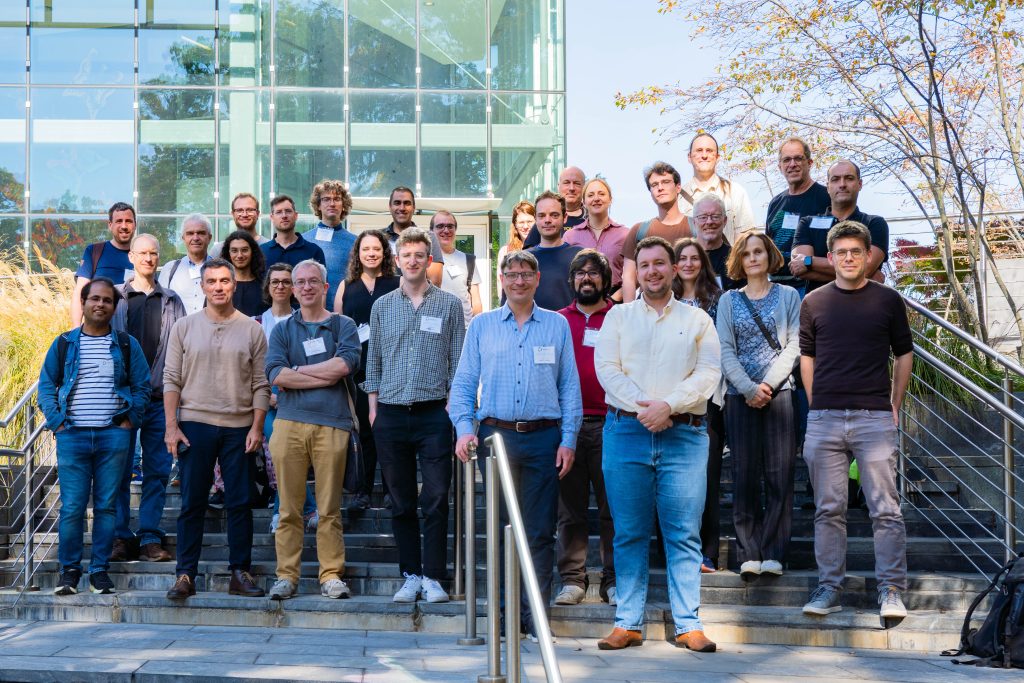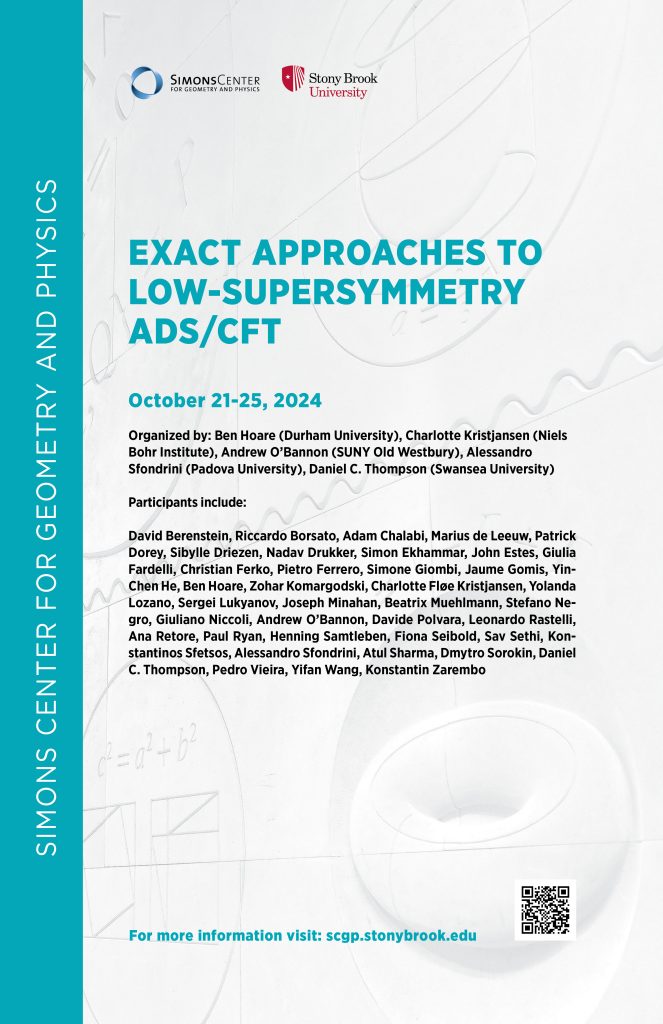Danfords shuttleScheduleParticipant ListView Videos
Organized by:
- Ben Hoare (Durham University)
- Charlotte Kristjansen (Niels Bohr Institute)
- Andrew O’Bannon (SUNY Old Westbury)
- Alessandro Sfondrini (Padova University)
- Daniel C. Thompson (Swansea University)
Exactly-solvable models are a cornerstone of theoretical physics: they allow a detailed understanding of new phenomena and provide the starting point for all approximations and numerics. These models have long been believed to be exceedingly rare due to their rich symmetry structure. A cluster of recent discoveries has revolutionized this perspective, exposing a vast web of exactly-solvable models related to each other through integrable deformations and dualities.
These ideas have been especially fruitful in the context of holography. Exact solvability of planar N=4 supersymmetric Yang-Mills theory has given us an unprecedented ability to interpolate between weak and strong coupling, not only in the case of the spectrum of non-protected local operators of the theory but also for quantities such as the qq-potential and the Hagedorn temperature of the dual string theory. These achievements might have appeared to be tied to the rather rigid and highly (super)symmetric nature of that AdS/CFT set-up. Yet, over the last few years we are coming to understand that many of those integrable
structures can be deformed and generalized, often yielding multi-parametric integrable models. The major avenues of exploration in this context are:
1. The inclusion of boundaries and defects, such as domain walls, Wilson or ‘t Hooft lines (branes, in the string picture) which break supersymmetry, partially or completely, but leave a sufficient amount of symmetry to exactly determine e.g. one-point functions. Work in vector models and in Chern-Simons matter theories have catalysed progress in providing a full quantum evaluation of defects.
2. The study of lower-dimensional AdS/CFT setups, where the maximal amount of supersymmetry is limited, and more parameters naturally play a
role, with the possibility of interpolating between superstring backgrounds of Wess-Zumino-Novikov-Witten type and those supported by Ramond-Ramond fluxes. Important lessons for these setups have also come from progress constructing the gravitational duals of gauge theories at zero coupling.
3. The study of integrable deformations of (superstring) sigma models, which over the last few years has been made systematic within the language of Yang-Baxter deformations, Poisson-Lie T-dualities and higher-dimensional Chern-Simons theories. These are supplemented with a remarkable universal class of TTbar deformations with exciting applications to holography.

Talk Schedule
| Time | Title | Speaker | Location |
| 8:30am | Breakfast | N/A | SCGP Cafe |
| 9:30am | Non-Supersymmetric ‘t Hooft lines and Wilson lines in N=4 SYM | Zohar Komargodski | SCGP 102 |
| 10:30am | Coffee Break | N/A | SCGP Cafe |
| 11:00am | Exact Holography And Surface Operators | Jaume Gomis | SCGP 102 |
| 12:00pm | Lunch | N/A | SCGP Cafe |
| 1:00pm | Higher-loop integrable S-matrices from tree-level data | Davide Polvara | SCGP 102 |
| 2:30pm | Towards holography for N = 4 self-dual Yang Mills | Atul Sharma | SCGP 102 |
| 3:30pm | Tea Time | N/A | SCGP Cafe |
| 4:00pm | ’t Hooft loops, fishnets and integrability | Kostya Zarembo | SCGP 102 |
| Time | Title | Speaker | Location |
| 8:30am | Breakfast | N/A | SCGP Cafe |
| 9:30am | AdS3/CFT2 and defect CFTs | Yolanda Lozano | SCGP 102 |
| 10:30am | Coffee Break | N/A | SCGP Cafe |
| 11:00am | On Complex Liouville String | Beatrix Muelhmann | SCGP 102 |
| 12:00pm | Group Photo | N/A | SCGP Lobby |
| 12:00pm | Lunch | N/A | SCGP Cafe |
| 2:30pm | Auxiliary Field Deformations of Sigma Models | Christian Ferko | SCGP 102 |
| 3:30pm | Tea Time | N/A | SCGP Cafe |
| 4:00pm | Using the integrability of all Yang-Baxter models | Sibylle Driezen | SCGP 102 |
| Time | Title | Speaker | Location |
| 8:30am | Breakfast | N/A | SCGP Cafe |
| 9:30am | Huge Operators in AdS/CFT | Pedro Viera | SCGP 102 |
| 10:30am | Coffee Break | N/A | SCGP Cafe |
| 11:00am | TBA | Sav Sethi | SCGP 102 |
| 12:00pm | Lunch | N/A | SCGP Cafe |
| 1:00PM | Honoring Jim Simons’ Impact on Campus | SBU | SCGP 103 |
| 6:00pm | Workshop Banquet Dinner – Danfords Hotel & Marina | N/A | Danfords Hotel & Marina |
| Time | Title | Speaker | Location |
| 8:30am | Breakfast | N/A | SCGP Cafe |
| 9:30am | Mass spectra and higher-order couplings for AdS vacua using Exceptional Field Theory | Henning Samtleben | SCGP 102 |
| 10:30am | Coffee Break | N/A | SCGP Cafe |
| 11:00am | Quantum M2 branes and holography | Simone Giombi | SCGP 102 |
| 12:00pm | Lunch | N/A | SCGP Cafe |
| 1:00pm | Strongly Coupled N=4 SYM via Integrability | Simon Ekhammar | SCGP 102 |
| 2:30pm | Integrable deformations of AdS3 string | Fiona Seibold | SCGP 102 |
| 3:30pm | Tea Time | N/A | SCGP Cafe |
| 4:00pm | A spin-chain with Jordanian twist for deformations of AdS/CFT | Riccardo Borsato | SCGP 102 |
| Time | Title | Speaker | Location |
| 8:30am | Breakfast | N/A | SCGP Cafe |
| 9:30am | The Hagedorn temperature in N=4 super Yang-Mills | Joe Minahan | SCGP 102 |
| 10:30am | Coffee Break | N/A | SCGP Cafe |
| 11:00am | Holography and the Large Spin Spectrum of Multi-Twist Operators | Giulia Fardelli | SCGP 102 |
| 12:00pm | Lunch | N/A | SCGP Cafe |
| 1:00pm | On Supergravity and Noncritical Strings | Pietro Ferrero | SCGP 102 |
| 2:30pm | From Topological to Non-Topological Conformal Defects | Yifan Wang | SCGP 102 |
| 3:30pm | Tea Time | N/A | SCGP Cafe |
| 4:00pm | Constrained Integrable Systems and Non-Invertible Symmetries | Marius de Leeuw | SCGP 102 |


